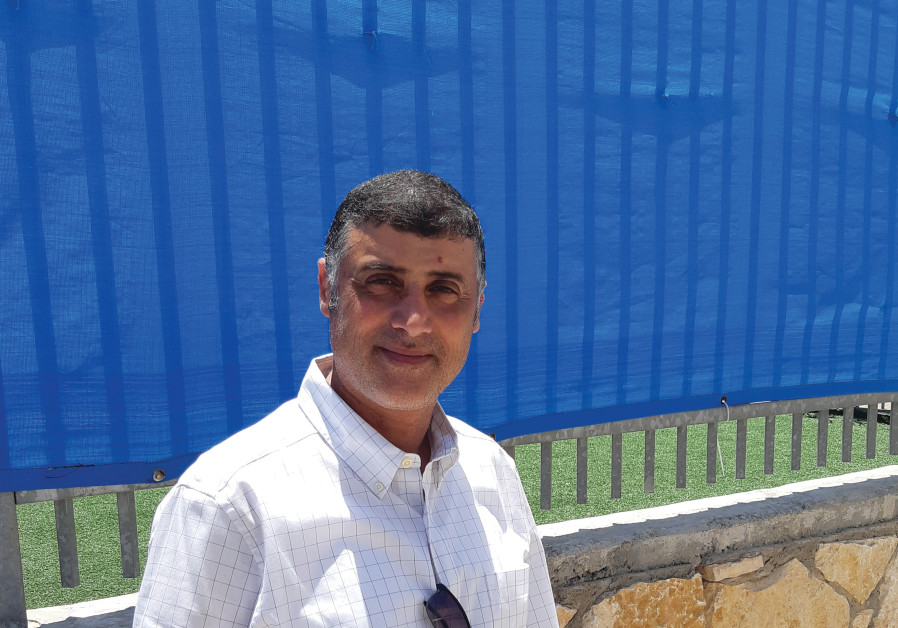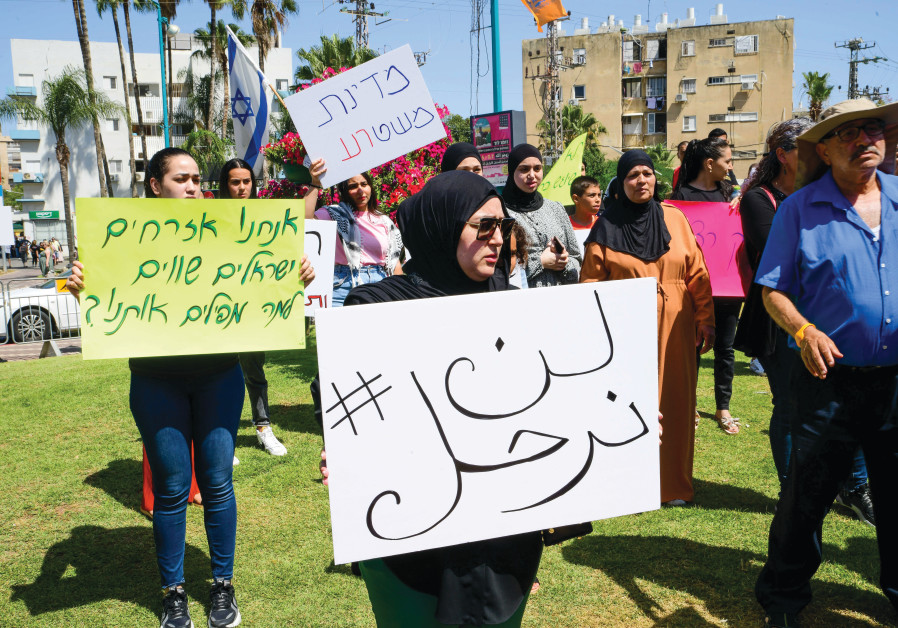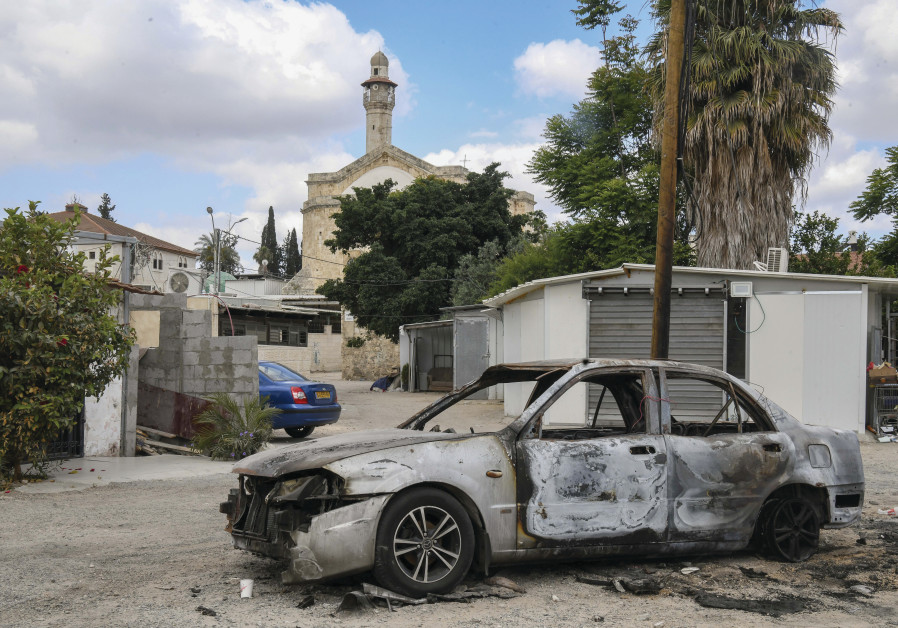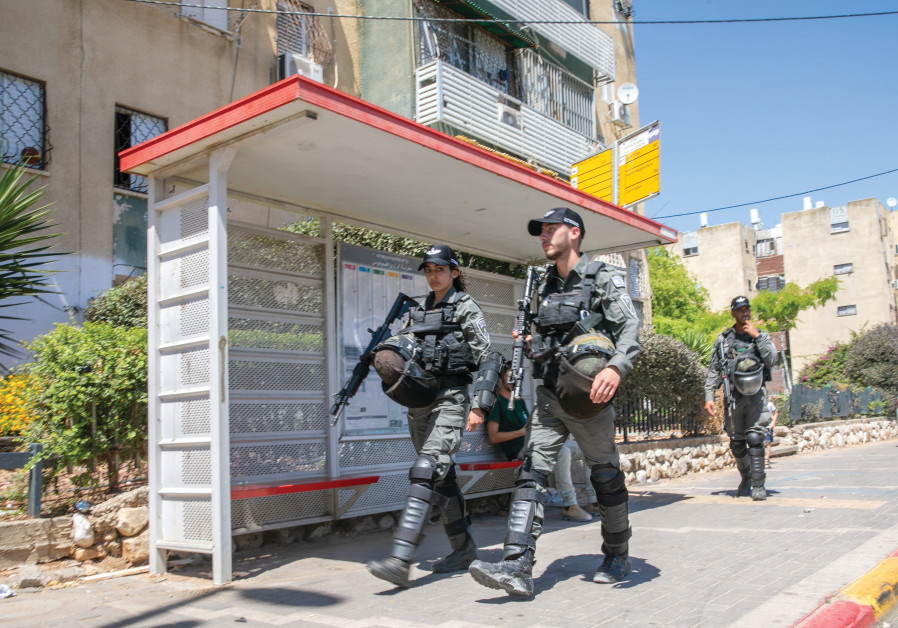A black car comes to a sudden stop on Exodus Street in Lod last Wednesday just in front of the Maoz pre-army academy, partly gutted in the rioting in the mixed Jewish-Arab city two weeks earlier.
The Arab driver rolls down the window of the car’s passenger side and shouts at Noam Dreyfus, the head of the academy, “I want to ask you a question: Why did you lie?”
With a short-cropped beard and a brown knit kippah, Dreyfus approaches the car, puts his hand on the rolled-down window, and says, “OK, brother, tell me what is the truth?”
“They didn’t come with petrol bombs and rocks and burn houses. And I’m against burning synagogues. There were not 10 synagogues burnt in Lod.”
“There were three,” Dreyfus says.
“Two,” the man answered. “One was only the door.”
“What did I lie about?” Dreyfus asks.
“You made it seem as if we are the invaders. You came here, we did not come to you.”
“But who was here first?” Dreyfus asks about the Ramat Eshkol neighborhood where he was standing, the epicenter of the rioting that rocked the city and jolted the country on May 10. “In the beginning, this was a Jewish neighborhood.”
A car behind the driver honks, as traffic is beginning to pile up while these two Lod residents discuss who had the earliest claim on the neighborhood. The Arab driver drives off, leaving the issue hanging, unresolved.

Four days of rioting that made Lod feel like Belfast during the “Troubles” left one Arab and one Jew killed, several people injured from gunshots, a few hurt in knifing incidents, four synagogues burned, a number of apartments firebombed and destroyed, dozens of cars set alight, and numerous windows broken on cars, synagogues, mosques and stores. The rioting took place as Israel was coming under attack from Hamas rockets in Gaza.
“What happens now? Where do things go from here?” Dreyfus is asked.
“That’s a good question,” he replies. “I don’t know.
“I’m originally from Bet El. There we had a fence. Here there is no fence. I want to create a normal life. For years we lived the left-wing dream here, Jews and Arabs living together in the same apartment buildings. A community center – ‘Chicago’ – had programming for Jews and for Arabs. I wouldn’t call what we had coexistence, but living together.”
Dreyfus spoke while giving a walking tour of the Ramat Eshkol neighborhood, which bore the brunt of the rioting. On the “tour” he points to one building where the staircases were repaired and the exterior spruced up only after Jews moved in some 15 years ago. He points to the exterior of another rundown-looking building, where Jews and Arabs live side by side, noting that Jews are living in the apartments from which Israeli flags are flying.
He notes a pile of rubble, including aluminum sheets and rods, in the corner of a parking lot, and says it was once a temporary structure the city recently destroyed after a rock was hurled from behind it onto a neighborhood preschool that now – only now – has a guard in front of it. It is a Jewish preschool. The Arab preschool directly next door needs no guard.
Dreyfus points out where shots were fired at Jews on May 13, and where several cars were torched. He shows a video of rocks being thrown and people running for cover in a parking lot. It is the same parking lot where he is standing at that moment.
Dreyfus’s tour culminates in the apartment of Sivan Danin. Apartment is a misnomer. It is a charred shell of an apartment. On Thursday night, the fourth night of the violence when Danin and her husband went to her parents in Yavne to get out of harm’s way, rioters and looters pounded a hole in an outdoor wall – a pounding noise that must have been audible to other neighbors in the building who did not stop the carnage – and set the place alight.
Last Wednesday Danin was with an assessor assessing the damage. The assessor did not need much experience to realize that this gutted apartment, with a half-burned piano still standing in the living room, was a “total loss.”
“We were with our parents,” Danin says. “It’s a good thing. Had we been here they would have killed us, simply killed us.”
Danin lived in the apartment, along with five other Jewish families in a building of 16 apartments for some 15 months. One of the most chilling things about the incident, one that bothers her the most, she says, is the question: Where were the neighbors, and what did they do?
“Do you intend on coming back to live here?” she is asked.
“Right now we are afraid for our lives. We don’t believe the police will protect us if it happens again.”
WHILE ON the surface life has returned to a semblance of normalcy in Lod, a city of 80,000 people, including one-third Arabs, that surface is very thin.
There are no easy answers, there is no magic wand. The explosion in Lod was the result of combustible material that had been piling up for years. All that was needed was a spark – one that came in the form of riots at al-Aqsa Mosque, the specter of evictions in Jerusalem’s Sheikh Jarrah neighborhood and outside incitement – and boom, the explosion went off.
The pre-army academy was one of the main targets for rioters on the first night of rioting, and its synagogue/beit midrash was burned, with many holy books set on fire. For Lod Arabs, this building is the symbol of Jews – they call them “settlers” – moving into Lod with a sinister, master design to replace them. The Arabs in town see Maoz as the vanguard of the Garin Torani (a group of religious Jews who began moving into the neighborhood in 2005), which they view as a threat to their existence.
Assaf Weiss, who grew up in Ma’alot, was one of that wave of young religious Jews who moved into Lod some 15 years ago and helped set up the pre-army academy.
The idea was to move into a neighborhood that at one time was Jewish, but which became so blighted and tough that all who could leave did so. Weiss is speaking in the kitchen of his apartment, frying up an egg to take to his daughter at a school directly across the street from his home, now regularly patrolled by police and Border Police.
“All the Jews who could leave, left,” he says of the Ramat Eshkol neighborhood. “Who would want to live there? The idea was simply to come here to strengthen the community.”
Ramat Eshkol was originally a Jewish neighborhood. In the early 1990s, however, the government moved some 120 Palestinian “collaborators” – Palestinians who worked with Israel – into the neighborhood from the West Bank for their protection. This caused those Jews who could afford to move out to flee, leaving only those who didn’t have the money to go elsewhere. The state then moved 100 Ethiopian families in. Slowly the ratio of Jews to Arabs went from about 95:5 before 1992 to 60:40 in favor of the Arabs in 2000.
After the academy was set up, “Slowly, Jewish families came to live in Ramat Eshkol,” Weiss says. He says there was definitely an ideological element in the decision to move there: wanting to strengthen a dying Jewish neighborhood. But, he adds, there was also an economic motivation: Real estate was dirt cheap.
In 2010, Dreyfus recalls, three apartments could be bought in Ramat Eshkol for $100,000. Today the price for one is $300,000. And what was attractive about Lod? Primarily the location – eight minutes from the airport, 20 minutes from Tel Aviv.
Presently, Weiss says, some of those same Jews are moving out, or talking about doing so.
“They say they wanted to come to a quiet place, not where there is this kind of background noise, and where they have to be afraid. Things here now are a mess, and they say they didn’t pick up and move to Lod to live in a mess. If you ask me, it is sad – sad that a Jewish family has to leave this city, eight minutes from the airport, because they are afraid.”
Weiss, the head of an NGO called Ma’agalim that deals with at-risk youth, says there is uncertainty about one’s neighbors.

Like Dreyfus, Weiss also has no ready recipe for moving forward. Boycotting Arab businesses, which he says some Jews are recommending, isn’t the answer.

“If you ask me what needs to be done, I think the police have to take more initiative, provide people with a sense of security – Jews and Arabs. It can’t be that Arabs can build here illegally and nothing happens, or they fire off firecrackers whenever they want, testing the response, and nothing happens. That creates a perception that they are in charge.”
The police do not enforce the law, he says, because they simply don’t want to ruffle feathers, “they want quiet.” He calls this a singular lack of governance.
Together with the lack of governance, Weiss says the riots were also characterized by distinct signs of a “religious war.”
“I asked people what happened, and they replied, ‘You touched al-Aqsa.’ The fanatics live in paranoia. They believe the Jews, the Garin Torani, are coming to kick them out, that they are from the Shabak [Shin Bet]. They are paranoid that we want to kick them out and destroy al-Aqsa. Go convince them otherwise. Most of the people don’t have a problem, but the fanatics and the religious incite things.”
The combination of lack of governance and a religious war is a recipe for a “world war,” he says.
LIKE DREYFUS, Weiss also wants to give a walking tour.
On the way past Lod’s central mosque, fronted by a synagogue and mikveh, sit two Arab men on chairs in front of their rundown building.
“How are things,” Weiss – who doesn’t know the men – shouts at them.
“Not quiet,” the older of the two, Bassam Sheikh Yusef, replies. He invites Weiss to sit down.
Sheikh Yusef’s son, Adam, attributes the first night of riots to “a few kids, but not all of Lod took part.” He blames the violence on Jewish thugs from the far-right Lehava and La Familia for coming into the town and stirring up both passion and trouble.
“They walked with sticks and looked for cars, Arab cars. Then they bashed the windows in,” he says.
Adam says the quiet will return.
“Jews live in my building, I have no problem with them. The problem is the settlers.”
“Settlers” is a catch-phrase used to refer to those associated with the pre-army academy, or the Garin Torani. They could actually be from Jerusalem or Rosh Ha’ayin – not from any of the settlements beyond the Green Line – but to Sheikh Yusef they are “settlers”
“If you look deeply, the Jews cannot live here without the Arabs, and the Arabs cannot live here without the Jews. We need each other. I don’t want to live in an Arab state. I’m used to it here, used to the laws. In the Arabs states the law is not straight.”
The younger Sheikh Yusef says that the explosion was not only about al-Aqsa or Sheikh Jarrah, but rather the policies of Mayor Yair Revivo, whom he says did not distribute the resources in the city equitably between the Jews and Arabs.
“Revivo says he also does for Arabs. But what does he do? Only demolish homes. He only gives to the Jewish neighborhoods,” he maintains.
“They want to bring in settlers, and the settlers are racists. And so are those they brought in two weeks ago who caused all the problems.”
Bassam says that despite his Jewish neighbors, with whom he has friendly relations, he would not sell his apartment to a Jew.
“They could offer me five million shekels, and I wouldn’t sell. Besides, where would I go?”
Asked if that wasn’t racist, Adam replies for his father, “I have three apartments. A settler will come here and say he wants to pay double. I’ll sell and he will live next to my parents – a settler who was raised on hating Arabs. They don’t study Torah, only hating Arabs.
“I have no problems with Jews, I am only talking about the settlers who were living in the West Bank and Gaza, and who are now looking for a place to live where Arabs live. I’m not talking about regular Jews. On our first floor there is a religious Jew. But not a settler.”
Adam’s recipe for moving forward in Lod: Don’t let the “settlers” move in.
FIDA SHEHADA, a lifelong Lod resident, is one of six Arabs on the 19-seat municipality, representing the independent local al-Nahda Party.
“The problem is not whether Jews and Arabs can live next to one another,” she says. “The problem is a total lack of equality here. The simple people can live together. But it is impossible to talk to us about coexistence when there is a lack of equality that you see in budgets, in housing, in schools, in the language.”
Shehada says that had the police not intervened on May 10 during the local protest to “stop the siege on al-Aqsa, stop the wars, stop the eviction in Sheikh Jarrah,” then things would not have gotten out of hand. But, she stresses, the police and the municipality decided to use shock grenades. During that protest, rioters replaced the Israeli flag at the municipality with a Palestinian one.
“There were 1,500 settlers who came, about 500 of them armed with M-16s. The police need to investigate this. Lehava is a terror organization. What do they think, that we will just sit back and let them slaughter us?”
Shehada denies there ever was true coexistence in Lod, but that the residents had managed to weave “a delicate fabric of life together,” because people live next to one another. But she says that delicate fabric ended 20 years ago when the Garin Tornai arrived.
“I don’t hate Jews. It is not about that. This is much bigger than interpersonal relationships between two people. On that level things are okay and we can manage. The problem is not between me and my neighbor, we can get along. But there is a policy of separation and segregation here – it can’t work like that.”
Al-Aqsa, she says, also played a role.
“Israeli society needs to understand that there is a minority in the country that will not give up on their identity, and on their symbols.”
Asked whether she condemned the Arab violence, Shehada replies, “That is not my role. I clearly am opposed to violence and would never do anything violent or open a WhatsApp group to say, ‘Let’s beat people in the street.’”
“Then why not condemn the violence?” she is pressed.
“Because I understand the motivations. I understand that it is difficult after you are ignored for more than 73 years that you come to me after a bad night and tell me to condemn. That is not my job. I represent a community that is being treated unequally.
“For 73 years they say we are violent, why do I have to join that chorus? Why do I need to weaken the community that is defending itself, that is attacked around the clock in the media? The coverage was completely asymmetrical. So is that what is lacking for the Arab community, another voice to attack them?“
Thabet Abu Rass, co-executive director of the Lod-based Abraham Initiatives, an NGO that aims, according to its mission statement, “to fulfill the promise of full and equal citizenship” for all Israelis, says the reality needs to be overhauled in Lod.
Lod, stresses Abu Rass, used to be an Arab Palestinian city, and as such, the Arab residents there – like those in Haifa, Acre and Jaffa – “have a strong sense of ownership of the city: They want a sense of belonging and don’t feel a sense of belonging.”
The mayor and public policy in Lod, he claims, “marginalize and discriminate against the Arab community.” He charges there were huge gaps in services given to a new neighborhood for “settlers” and the town’s Arab neighborhoods.
Abu Rass also blames the problems on the “settlers,” saying that following the Gaza Disengagement in 2005, the settlement leadership decided the need to “settle in people’s hearts.” But, he asserts, “they chose to settle in the heart of the Arabs, not the Jews, since they came to mixed cities, bringing about a rise in the tension.”
Abu Rass says he has no problems with Jews and Arabs living together, “we have a problem when a group of Jews is coming not only to live, but to Judaize the urban space, coming into Arab neighborhoods or close to Arab neighborhoods.”
Asked what “Judaizing urban space” means exactly, he replies, “If you come to an Arab neighborhood and you find a very old building nobody is using, and they are passing it on to NGOs – very Zionist radical NGOs – who convert it to a synagogue or a center for young Jews. Judaizing the urban space means instead of making it available to young Arabs, offering it instead to Jewish people.”
Abu Rass, in explaining why things exploded this time, says, “What is happening in Sheikh Jarrah is really connected. It is the same policy of the evacuation of Arabs and replacing them with specific Jews, with settlers. It is the same policy that is happening in the old city of Jaffa, for example, in the historical Palestinian cities. This is frustrating the Arabs in those cities.
“It is pent-up anger that was waiting for a specific moment to explode. And these kinds of policies bring it to an explosion.”
YOSSI HARUSH, the Bayit Yehudi deputy mayor of Lod, has a much different take. With a large knitted kippah, he might be identified by area residents as a “settler,” though he is not – he was born and raised in Lod.
What happened on the first night of the rioting, he says in the Maoz academy as workmen repair damage to the beit midrash, had nothing to do with so-called settlers.
“Those who were rioting were not doing so because they want better schools or against house demolitions or electricity supply – they were rioting because they hate you, and if they are stronger than you, will kill you. They say, ‘I want al-Aqsa, and I am willing to be a martyr to get it.’”

“Then all of a sudden there was that nationalistic incitement coming from the Islamic Movement, the youth were incited, and some adults with them. I say with pain that it was not just a small minority. On WhatsApp and TikTok you see horrible hatred coming from teachers, preschool teachers, people you know – I didn’t think this could happen.”
That was the moment, he says, when the illusion of coexistence in the city burst.
“This showed that there is no real coexistence here, that al-Aqsa is more important, and that it is okay to burn the shared public space under the apartment building, as well as the neighbors’ home.”
Harush says it will take years to rebuild what was lost at that instant in Lod.
Speaking as if to the city’s Arabs, he says, “You live with me here, I buy from your grocery store, your hardware store, use your services to renovate my home – I work with you daily, and then all of a sudden the bubble bursts – and I see hate. We’ve seen protests here in the past. But here it was people throwing concrete blocks at you with hate in their eyes.”

The hatred is burning, he warns, and it needs to be extinguished. He advocates a two-pronged approach. The first is dialogue, but not Jewish-Arab dialogue where everyone sitting at a round table says what is politically correct, but rather holding separate sessions with both Arabs and Jews to discuss what it means to live in a mixed city, and what needs to be done to make it work.
And the second element is simple: zero tolerance for breaking the law, any violation of the law. Refraining from enforcing the law because it buys quiet is ineffective and can no longer be tolerated, he argues.
Harush says that coexistence is when a Jew sits down and drinks coffee in the garden with his Arab neighbor.
“Anyone who tells you there is coexistence here is a liar.” But, he says, there can be “shared living,” which is each side knowing the other is not going anywhere, and that as a result they just need to manage together as best they can.
True, that may sound like a very low bar. But even that is a place to start.
